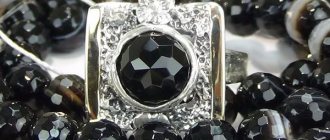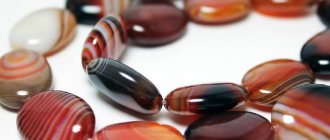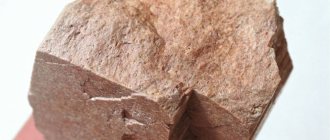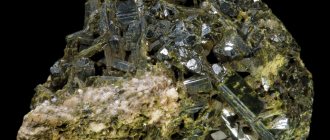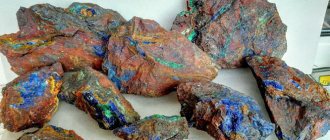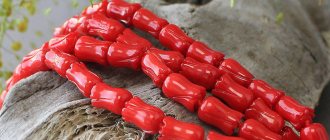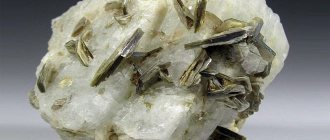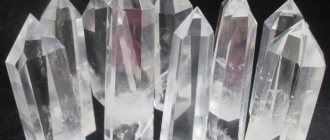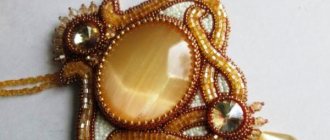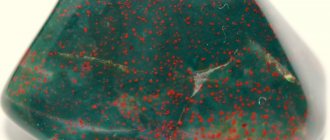/ List of stones / Description of black corals
0
3874
Article rating
Fossilized polyps form Black Coral. There are about 200 deep-sea species. Precious minerals form the sheer walls of the reefs. The dark skeleton of fossilized organic remains is used in jewelry making. Black coral jewelry is highly valued all over the world. The cost can reach tens of thousands of dollars.
Description of black corals
Description of the stone
In Greek, “coral” means “son of the sea.” Essentially, this is the skeleton of a polyp. Black coral looks like a small bush with fluffy branches. The stone does not transmit light and has a waxy shine. The second name of the mineral is Akkabar.
The stone is shrouded in myths and beliefs:
- When Perseus was able to cut off the head of the gorgon Medusa, the blood flowed in streams into the water, where it turned into coral;
- the Romans used it to treat wounds, as an antidote to snake and insect bites;
- in the Middle Ages it was a symbol of kindness, modesty, protection from evil spirits;
- in Rus' it personified a happy family life and was given as a wedding gift.
Black coral grows very slowly at a depth of more than 100 m or in a cave or grotto - it does not tolerate the light of the sun. It needs a warm underwater current that carries its main food - plankton.
View this post on Instagram
Publication from Girls Only!!? (@mareeam8888) Nov 3, 2021 at 12:32 pm PDT
Recommendations
- ^ a b
Tina Molodtsova, Denis Opresko (2020).
"Antipatary." Worms
. World Register of Marine Species. Retrieved May 13, 2021. - ^ a b c
Opresko, Dennis.
"The focus is on the antipatarians (black corals)." NMNH
. Retrieved May 4, 2021. - ^ a b
Bo, Marcia (April 21, 2012).
“Isolation and identification of chitin in black coral. Parantipathes larix
(Anthozoa: Cnidaria) ".
International Journal of Biological Macromolecules
.
51
(1–2): 129–137. doi:10.1016/j.ijbiomac.2012.04.016. PMID 22546360. - ^ a b c d f f gram
“In the spotlight of antipatarians.”
NMNH
. April 18, 2021. Retrieved September 4, 2021. - Grigg, Richard W. (1993). "Gem Coral Fisheries in Hawaii and the U.S. Pacific Islands" (PDF). Marine Fisheries Review
.
55
(2):54. Retrieved September 29, 2010. - Skeete, Walter William (1906). Pagan races of the Malay Peninsula: pt.
3. Religion. Fri. 4. Language. Application. Comparative Dictionary of Aboriginal Dialects. Index of items. Index of proper names. Index of native words . McMillen and company. ISBN 1149951974. - Brugler, Mercer, R.; France, Scott K. (March 2007). "The complete mitochondrial genome of the black coral Chrysopathes formosa
(Cnidaria: Anthozoa: Antipatharia) supports classification of antipatharia in the subclass Hexacorallia."
Molecular phylogenetics and evolution
.
42
(3):776–778. Doi:10.1016/j.ympev.2006.08.016. PMID 17049278. Retrieved May 4, 2021. - ^ a b
NOAA.
"Black Corals of Hawaii." oceanexplorer.noaa.gov
. - ^ a b c d f f gram h i j
Wagner, Daniel (December 2011).
Biology and Ecology of Hawaiian Black Corals (Cnidaria: Anthozoa: Hexacorallia: Antipatharia)
(Ph.D.). University of Hawaii at Manoa. - Dennis Opresko (2019). "Antipatary." Worms
. World Register of Marine Species. Retrieved November 25, 2021. - "Black Coral: The Jewel of the State of Hawaii." State symbols of the USA
. Retrieved September 13, 2021. - ^ a b
Goldberg, W. M.;
Grange, K. R.; Zuniga, A. L. (August 1990). "Structure of panicle tentacles in the black coral Antipathes fiordensis
."
Biological Bulletin
.
179
(1):96–104. Doi:10.2307/1541743. JSTOR 1541743. PMID 29314907. - Milne-Edwards and Hayne. "Antipatharia sp (Milne-Edwards & Haime, 1857): "Black coral." EdwardsLabs
. Retrieved October 30, 2021. - Bo, Marcia; Wijgerde, Tim. "Black corals". Reefs
. Reefs. Retrieved May 4, 2021. - ^ a b c
Wagner, Daniel;
Toonen, R. J. (2012). "Biology and ecology of black corals (Cnidaria: Anthozoa: Hexacorallia: Antipatharia)". Advanced Marine Biology
.
63
(132): 63–67. Doi:10.1016/B978-0-12-394282-1.00002-8. PMID 22877611. - ^ a b c d f g gram hour
“Black Coral”.
Waikiki Aquarium
. 2013-11-21. - Boland, Raymond C.; Parrish, Frank A. (July 1, 2005). “Description of fish assemblages in black coral beds off the coast of Lahaina, Maui, Hawaii.” Pacific Science
.
59
(3):411–420. doi:10.1353/psc.2005.0032. HDL:10125/24187. S2CID 41135750. - Murphy, Richard K. (2002). Coral Reefs: Cities Under the Sea
. The Darwin Press, Inc. ISBN 978-0-87850-138-0. - Bo, Marcia; Baker, Andrew S.; Gaino, Elda; Wirsching, Herman H.; Scoccia, Francesca; Bavestrello, Giorgio (2011). "First description of algal mutualistic endosymbiosis in a black coral (Anthozoa: Antipatharia)". Marine Ecology Progress Series
.
435
(13):1–11. Bibcode:2011MEPS..435 …. 1B. Doi:10.3354/meps09228. - Goldberg, Walter M. (1991). “Chemistry and structure of skeletal growth rings in black coral. Antipathes fiordensis
(Cnidaria, Antipataria)."
Developments in hydrobiology
.
66
(216/217): 403–409. Doi:10.1007/978-94-011-3240-4_58. ISBN 978-94-010-5428-7. - Grigg, Richard (April 1965). "Ecological studies of black coral in Hawaii." Pacific Studies
.
19
: 244–260. Retrieved November 12, 2021. - Parker, N. R.; Mladenov, P. V.; Grange, K. R. (November 1997). “Reproductive biology of antipatarian black coral. Antipathes fiordensis
in Doubtful Sound, Fiordland, New Zealand."
Marine Biology
.
130
(130): 11–22. Doi:10.1007/s002270050220. S2CID 85999468. - Roark, E. B.; Guilderson, T. P.; Dunbar, R. B.; Fallon, S.J.; Mucciarone, D. A. (February 10, 2009). "Extraordinary longevity of proteinaceous deep-sea corals". Proceedings of the National Academy of Sciences of the United States of America
.
106
(13):5204–5208. doi:10.1073/pnas.0810875106. PMC 2663997. PMID 19307564. - Graczyk, Michael (25 March 2009). “Scientists have determined that living coral is 4,265 years old.” Associated Press.
- ^ a b c d
Bruckner, Andrew W. (2016), "Advances in precious coral management to address challenges posed by unsustainable and destructive harvesting practices",
Cnidaria, Past, Present and Future
, Springer International Publishing, pp. 747–786 , Doi:10.1007/978-3-319-31305-4_46, ISBN 9783319313030 - Wagner, Daniel; Luck, Daniel J.; Toonen, Robert J. (January 1, 2012). Biology and ecology of black corals (Cnidaria: Anthozoa: Hexacorallia: Antipatharia)
.
Advances in Marine Biology
.
63
. pp. 67–132. Doi:10.1016/B978-0-12-394282-1.00002-8. ISBN 9780123942821. ISSN 0065-2881. PMID 22877611. - Hickson, Sidney J. (July 1922). "Black Coral". Nature
.
110
(2754): 207–208. Bibcode:1922Natura.110..217H. Doi:10.1038/110217a0. Retrieved October 28, 2021. - Grigg, Richard W. (July 1, 2001). "Black Coral: A History of Sustainable Fisheries in Hawaii" (PDF). Pacific Science
.
55
(3):291–299. Doi:10.1353 / pcs.2001.0022. HDL:10125/2453. ISSN 1534-6188. S2CID 38992352. - Kenyon, J. (1984). "Black coral off the coast of Cozumel." Maritime boundaries
.
30
: 267–272. - Padilla, C., & Lara, M. (2003). Banco Chinchorro: the last refuge of black corals in the Mexican Caribbean. Bulletin of Marine Science
,
73
(1), 197–202. - Gress, Erica; Andrady-Brown, Dominic A. (July 4, 2021). "Assessing population changes in historically overexploited black corals (Order: Antipataria) on Cozumel, Mexico." PeerJ
.
6
: e5129. doi:10.7717/peerj.5129. ISSN 2167-8359. PMC 6035717. PMID 30013832. - "Applications". CITES
. Retrieved October 29, 2021. - Montgomery, Anthony D. (March 2002). "Possibility of transplanting black corals (order Antipataria)." Hydrobiology
.
471
(4711): 157–164. Doi:10.1023/A: 1016573926566. S2CID 12598714. - ^ a b
Terrana, Lucas;
Todinanahari, Gildas Georges Boleslas; Eeckhout, Igor (24 June 2021). Illegal mining and trade of black corals (Antipataria) in Madagascar: the need for field research
. 13th International Coral Reef Symposium. - ^ a b
"An example of the use of black coral from Hawaii" (PDF).
CITES
. Retrieved November 4, 2021. - Grange, K. R. (18 February 1985). "Distribution, standing yield, population structure and growth rates of black corals in the southern fjords of New Zealand." New Zealand Journal of Marine and Freshwater Research
.
19
(4): 467–475. Doi:10.1080/00288330.1985.9516111. - "How does climate change affect coral reefs?" NOAA
. Retrieved October 28, 2021. - Ginott, John (2005). "Climate Change and Deep Sea Corals" (PDF). Journal of Maritime Education
.
21
(4). Retrieved November 4, 2021.
Coral mining and processing
It is not widely distributed throughout the oceans and seas; the main production points are Cuba, the Red Sea, and India. Fishing is prohibited in many places.
Black coral is mined using 2 long beams with nets attached to the ends. Minerals are lifted, cleaned, and sorted by hand. Then the master cuts the stones into blanks and polishes them. Most often they do:
- beads;
- rose;
- cabochon;
- circle;
- oval.
The final stage is soaking in a special solution for 36 hours to clean the surface and add shine.
How to distinguish from a fake
The quantity of black corals is limited, demand and price are high. On the jewelry market they give out the following for a stone:
- Fake. For imitation, colored glass, colored limestone or plastic are used.
- Artificial mineral. It has been produced since the 20s of the last century by burning calcite. Only a connoisseur can distinguish it from the original.
- Pressed coral. It is obtained by grinding substandard fragments into powder and then shaping them into a ball, oval, etc.
The following features will help you distinguish a real original from a fake:
- glass fakes are heavy and cold;
- limestone is easily scratched with a needle, leaving a white furrow;
- when heated, plastic melts, emits a characteristic odor, and the natural mineral cracks;
- prolonged exposure to water makes the natural mineral brighter;
- the price of a fake is lower, the difference can be 10–30 times.
See what the stone looks like:
Mineral care
Corals are difficult to care for. In order for the product to serve for many years, the following recommendations should be followed:
- protect the mineral from any mechanical impact - shock, scratching, squeezing, falling;
- exclude contact of the mineral with any chemicals - dishwashing and laundry detergents, cosmetics, perfumes;
- store corals at room temperature and a normal level of humidity - a sharp temperature change, high humidity or, conversely, too dry air can lead to damage to the integrity of the mineral;
- to store coral, use a separate box, and wrap the mineral itself in tissue paper (storing corals in polyethylene is not allowed);
- To clean corals from contamination, use a damp cloth; to dry, use a dry piece of flannel.
Properties and uses of coral
The formula of Akkabar is Ca(CO)3, based on calcium carbonate with admixtures of magnesium, iron, and manganese. Physicochemical characteristics:
- hardness on the Mohs scale 3.5–4 points;
- opaque;
- density 1.3–2.6 g/cm3;
- after processing it acquires a glass shine;
- there is no crystalline base - the mineral is amorphous;
- contains inclusions, pores;
- decomposes under the influence of acids and high temperatures.
The main use of the stone is jewelry, souvenirs, and less commonly used in lithotherapy and magical practices.
Medicinal properties
Black coral is endowed with healing properties and is used for:
- joint diseases;
- neuroses;
- migraine;
- eye diseases;
- insomnia;
- pharyngitis, laryngitis;
- obesity.
It is not worth treating with black coral alone. It is better to combine it with traditional medicine.
To watch a video review about the healing properties of corals:
Magic properties
Black corals have been used as amulets and amulets since ancient times. It is still believed that he can:
- make men more courageous, women more tender;
- remove danger;
- protect from slander and prying eyes;
- develop logic and intuition;
- give peace and tranquility.
There are different effects on people depending on the zodiac sign:
- Aries will become more patient with others;
- Taurus will be distinguished by wisdom and self-control;
- It will help Gemini to avoid acute situations and dangers;
- Cancer will increase sexual energy;
- Leo should not wear a stone - he will become lazy and selfish;
- for Virgo it will be a symbol of love;
- It will help Libra to make choices faster and avoid lengthy weighing of solutions;
- Scorpio and Sagittarius will become a guide to patience;
- Will make Capricorns more romantic;
- does not affect Aquarius;
- will make Pisces more active and self-confident.
People with the names Arthur, Bogdan, Victor, Victoria, Nikanor, Nonna will feel the positive influence of the stone to the maximum.
Please watch a video review that contains information about the stone:
Medicinal properties
We can talk about the medicinal properties for a very long time and a lot. Literally, coral can be used to prevent most known diseases, and it also treats them quite well. In ancient times, healers ground these stones into powder and used it to heal open wounds , ulcers and treat some heart diseases.
Already in our time, scientists have found biostimulants in corals that can treat diseases of the liver, stomach, and spleen, especially in the presence of ulcers. In addition, this stone helps with fever and joint pain. It has already been said that in ancient times girls were given coral beads. In addition to the fact that this gem is a stone of innocence, the red color of the stone gave the skin a special charm and made it look younger.
Nowadays, beads or earrings made of red coral are also used not only as decoration, but also to improve skin tone. White stone is an excellent implant for bones and teeth. The large amount of calcium in this stone plays an important role. And calcium, as you know, is important for the strength of bones and teeth.
In addition, white coral is used to enrich water . Without exaggeration, we can say that the water into which a white coral has been immersed for a couple of days becomes “living” water. After enrichment, it contains about seventy useful substances that were not there before. Particularly important is the same calcium, which in ionic form is very easily absorbed by the body. “Coral” water improves metabolism, rejuvenates the body, removes harmful substances, and improves immunity. In addition, this water reduces acidity, and this directly affects the acid-base balance. Excessive acidity of the body can cause a number of diseases - the circulatory system, gastrointestinal tract, cardiovascular system.
The water in which the coral has been does not contain heavy salts or impurities. This is pure water with a huge amount of useful elements. Coral stones can treat:
- various mental illnesses;
- headache;
- bronchitis;
- sore throat;
- asthma;
- cancer;
- cataracts and many other diseases.
In ancient times and the Middle Ages, coral chips were included in most medicinal preparations, and nowadays medicine often begins to turn to this stone. This stone can be used for both treatment and prevention of diseases. It is enough to carry it with you, either as a decoration or just as a pebble in your pocket. Coral is often placed at the head of the bed to improve sleep, get rid of difficult awakenings in the morning and insomnia at night. In addition, this stone will save you from nightmares.
Black coral jewelry
Black coral is used to make jewelry:
- beads;
- earring;
- necklace;
- rings;
- bracelets;
- hair jewelry.
The frame is made of gold, silver, platinum. The mineral is often combined with rubies, garnets, and emerald.
Basic care rules that will help you wear your jewelry for many years:
- store in a case;
- clean when soiled with warm water and soap;
- After washing, dry with a soft towel;
- do not keep in direct sunlight to prevent fading;
- do not wash in hot water;
- don't drop it.
You can wear black mineral jewelry with many shades of clothing. It goes best with white, yellow, gray, beige, blue, black. Successful combinations:
- bright summer dress and bracelet;
- blue jeans, gray sweater and necklace;
- red dress and earrings;
- light-colored office suit and ring.
View this post on Instagram
Publication from VIP_vintage (Inna, Moscow) (@vip_vintage) February 25, 2019 at 4:48 PST
View this post on Instagram
Posted by Vintage Jewelry (@antique1911) Dec 6, 2021 at 12:03 pm PST
View this post on Instagram
Posted by Jewelry Designer Alla (@alla.butik4you) Oct 10, 2018 at 4:25 PDT
Stone cost
Black coral is a relatively expensive stone. Earrings and a bracelet will cost from 5,000 rubles, a ring can be found from 2,500 rubles, prices for pendants and necklaces range from 5,000 to 15,000 rubles.
The cost of a product is determined by the components included in it - the most expensive piece of jewelry was sold for $34,000. It was a diamond owl sitting on a branch of black coral.
Black coral is a rare find in the sea. A fragile, amazing stone, wearing which can change the owner for the better, attract attention to him, and help in the fight against disease.
What else do you think black coral jewelry will be combined with? Share the article with your friends on social networks.


